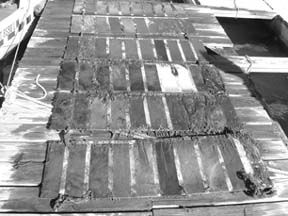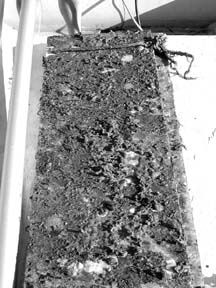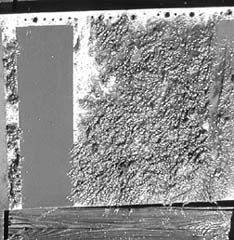About the only thing that’s predictable about them is that they’re unpredictable. That’s what the experts say about sharks and twisters, and we’ve always said the same thing about anchors and bottom paints. There are so many real-world variables affecting their performance that it really takes years of observation, and in many circumstances, to learn which ones to bet on in the long haul.

This year’s bottom paint experiment was as full of little surprises as it has been in the past, so at least things are consistent in the unpredictability department.
Test Procedures
As always, the paints were applied painstakingly, following manufacturers’ intructions to the letter. We used new, pre-cut sheets of polyester-resin fiberglass, prepared with de-waxing solvent, thorough sanding, and washing with more solvent. Equal sections were taped off, and each section drilled for identification with an six-digit binary code.
Fifty-four paints were applied. That’s right, 54. Of course that’s too many to choose from, just as there are too many kinds of breakfast cereal to choose from. But variety never stopped buyers from buying or makers from making. The difference is that you know what Captain Crunch will taste like next week.
Unless specifically instructed otherwise, we applied two coats of paint, and followed drying-time instruction carefully.
For the Connecticut-based panels, we followed the same procedure as we did the year before, lacing them with polypropylene line and then setting them in a “loop” with the painted sides of the panels facing out. We then suspended the loop under a floating dock subject to a strong tidal current, and visited regularly to rotate the arrangement one “notch” at a time, so that each sheet of panels was exposed to different depths and orientations throughout the testing period.
That testing period was three months, from mid-June to mid-September. We hauled the panels earlier than we’d planned, because there was a hurricane headed our way. It didn’t strike, but in any case the panels had seen more than enough fouling to let us go ahead with our evaluations.
This was surprise No. 1. We would have bet the farm on a light fouling year in Connecticut. It had been a long winter and cold spring, with a tremendous amount of rain well into the summer. No matter—it was a worse than average fouling season on the north side of Long Island Sound.
Meanwhile, in Florida, we couldn’t even invite enough organic matter to make a side salad. We immersed the panels in floating racks in a tidal estuary in Sarasota, and left them there for almost seven months. When we pulled them out for close inspection, we got surprise No. 2: The sheets were hardly fouled at all. There were some good-sized clusters of barnacles at the bottom ends of some of the completely unpainted panels, but otherwise no hard shell growth, no weed, no grass, and none of the really interesting stuff we get in Connecticut, like crepidula fornicata shell (aka “quarterdecks”) or sea grapes, or tendrilly blobs of orange-yellow sponge.They were almost uniformly covered in a light brown silty slime, or slimy silt, as you prefer. Even the unpainted strips between the painted panel areas showed the same uniform coating, and (weirdly enough) not in greater density. There was simply not enough gradation in the coverage to allow us to do a fair comparative rating.
We were conjecturing about brackishness and warmth in the estuary, the heavy rains of the summer and the likely runoff of fertilizers and pesticides from surrounding yards (the neighborhood is quite built-up), and a number of other factors—but when we described the scene to a friend who is a professional shellfisherman and aquaculturist, he immediatedly said, “Is it hot there? It sounds hypoxic.” That makes perfect sense: Quite possibly, there just wasn’t enough oxygen in the water to encourage much of anything to grow. We will investigate.
Meanwhile, on to this year’s ratings, derived from the Connecticut panels alone.
Rating System
We generally try to stick with a four-point rating system—poor, fair, good, and excellent. Poor, in this case, means that most of the panel is essentially obscured with growth. Excellent means the panel is clear of any growth—virtually pristine, and a rare rating. The Fair and Good ratings are trickier to apply, and their definitions have to change slightly year by year, according to the fouling conditions. This year we can take Fair to mean that a panel has an obscuring blotchiness over about half its surface, or a thin, consistent covering more widespread. Good means blotchiness or covering over a smaller part of the surface, or in a few isolated patches. Then, to differentiate within a rank, and to treat paints fairly relative to each other, we apply a “+” mark here and there.

There was no hard-shell growth on any of the panels this year, with the exception of the Dolphinite Go-Fast (see Paint Notes). This has been the case for several years, and is an indication of how advanced these coatings are today. In fact, a paint that rates Fair or Fair+ in these tests, especially since we “detuned” the ratings a few years ago, would probably have been regarded as excellent by most people a decade ago.
Most of the paints could easily have been cleaned by a sponge-rub, or power-washing, and all of them certainly would have benefited from movement through the water. Indeed, every year, Practical Sailor is taken to task by paint makers who say their paints are meant to be used on boats that move, not on stationary test panels, even with a good tide flowing past them. We don’t dispute that point at all. Yet the fact is, boats sit in their slips and on moorings, unattended and underused, for long periods of time. And we do see winners every year.
Paint Notes
Interlux’s Micron 66 emerged without any fouling, and gets the blue ribbon this year. Interlux Optima, which has done so well in years past, looked pretty good, but not top-shelf, with a thin, almost stainlike coating of slime. Call that surprise No. 3.
Though we use new cans of paint every year, Ed Donlin, maker of Super Shipbottom paint, asked us to use the leftover paint from the last test, which we did, and got the same results—light slime evenly distributed over most of the panel, that could easily be wiped off with a sponge. Ed is one of the paint makers who says his paint is designed to be run through the water for maximum effectiveness.
The two E-Paints, ZO and EP2000, again fared very well, as they have several times in recent years. They were essentially free of growth, but both carried orange-colored stains near the tops and bottoms of the panels, maybe from copper or other chemicals from nearby panels.
These white E-Paints, in our experience, are a bit susceptible to staining—we’ve seen brown and yellow stains when using the EP 2000 on a test boat. But it may be that stains simply stand out better on the white background. It’s the antifouling properties that count in this evaluation, so these paints are rated Excellent.
In the article on coatings for underwater metal in our February 1 issue, we ran a short bit on what happened to Dolphinite’s Go Fast, a resin-based paint meant for virtually any surface. To recap briefly, it became widely known by last summer that there was a problem with the paint. Dolphinite acknowledged the problem, and said that the Clean Seas Company of Jacksonville, Florida, designer and maker of Go Fast bottom paint, had provided a different formulation in the mass-produced product from that in test samples. Clean Seas, in turn, blamed Dolphinite for mishandling the paint and providing inadequate instructions.
There’s currently a nationwide class action lawsuit against both Dolphinite and Clean Seas, seeking damages for consumers who had used either Go Fast or Dolphinite’s Inflatable Bottom Coat, also manufactured by Clean Seas.
For what it’s worth, our test panel with Go Fast emerged completely fouled, as if it had never been painted.
American Marine Coatings, makers of Copperpoxy, asked not to be included in this annual test, because their copper-impregnated resin is meant to be a multi-year system, and must be scrubbed to keep copper exposed. They did ask to be counted in the long-term testing.
We had six new (to us) coatings from Blue Water Marine Paint, part of a large paint conglomerate in New Jersey. The company itself is no stranger to the field. As it says on their website, “we owned (until the sale to Interlux Yacht Finishes) KL990, Gloucester Paint, Nautical Paint, and were the private label paint for West Marine, Boaters’ World, BoatU.S., and E&B Marine.”

Blue Water Marine’s offerings did well, with two Good ratings, but note that the instructions specifically require three coats, which we applied. Going by the letter of the law, this adds much to the cost per application.
There are always little mysteries when two paints which should be essentially the same, like West Marine’s CPP CoPolymer Plus (made by Interlux) and Interlux’s own Super Epoxycop, rate differently. In this case the West paint was quite Good, the Interlux firmly in the Fair zone.
Pettit’s Trinidad and Trinidad SR both did very well, with hardly any fouling. The SR just barely nosed out its brother paint. Unlike the Micron 66, it did have trace amounts of fouling, but it would have been quibbling not to give it an Excellent rating. It has been a consistent performer over the years.
The prices listed in the chart were found at press time at the websites shown alongside. You may be able to find better prices when it’s time to buy, but don’t forget to consider the steep shipping charges for website orders, versus cash-and-carry prices from chandleries. Most bottom paints are considered hazardous materials, and are heavy to ship.
Also With This Article
“Value Guide: Bottom Paints 2004.”
“Staying Powers.”
Contacts
• American Marine Coatings, 800/290-8836, www.copperpoxy.com
• Blue Water Marine Paint, 800/628-8422, www.bluewatermarinepaint.com
• E-Paint Company, 800/258-5998, www.epaint.net
• Flexdel Corp., 888/353-9335, www.aquagard-boatpaint.com
• Super Shipbottom, 800/466-7144, www.supershipbottom.com
• Interlux Yacht Finishes, 800/468-7589, www.yachtpaint.com
• Kop-Coat (Pettit, Woolsey), 800/221-4466, www.kop-coat.com
• New Nautical Coatings, 800/528-0997, www.seahawkpaints.com
• SeaLife Corp., 310/338-9795, www.sealife1000.com
• West Marine, 800/BOATING, www.westmarine.com
































